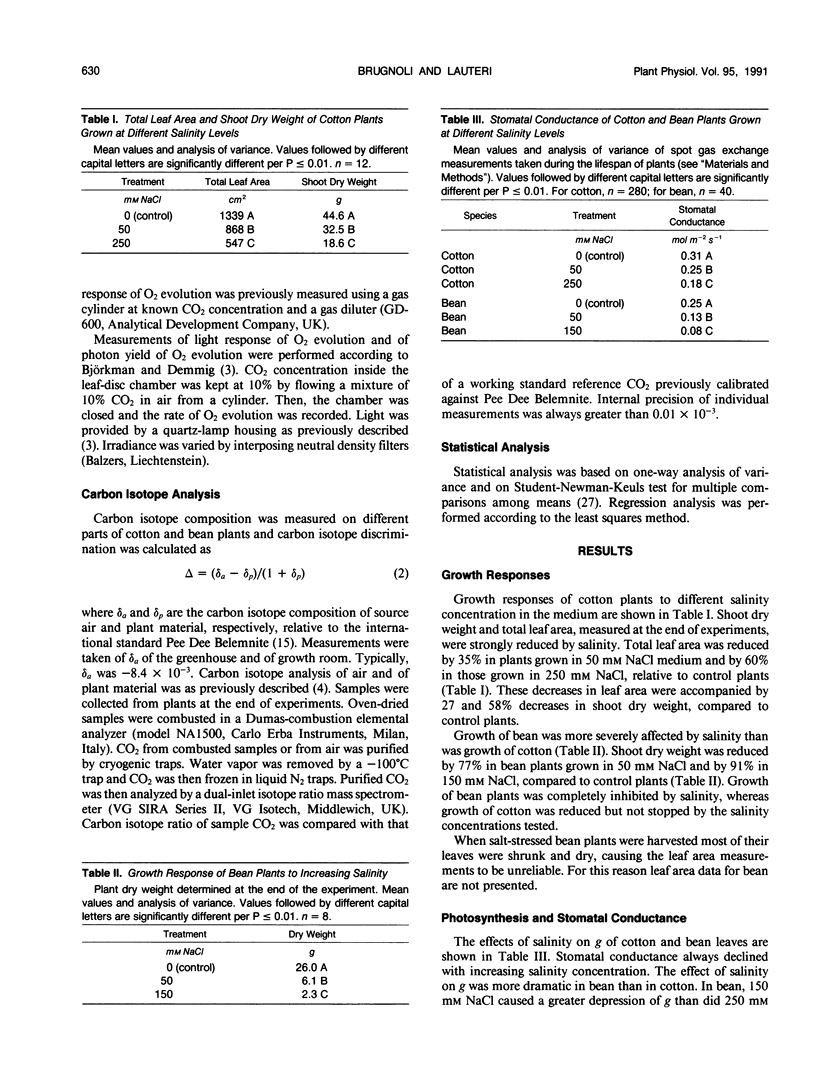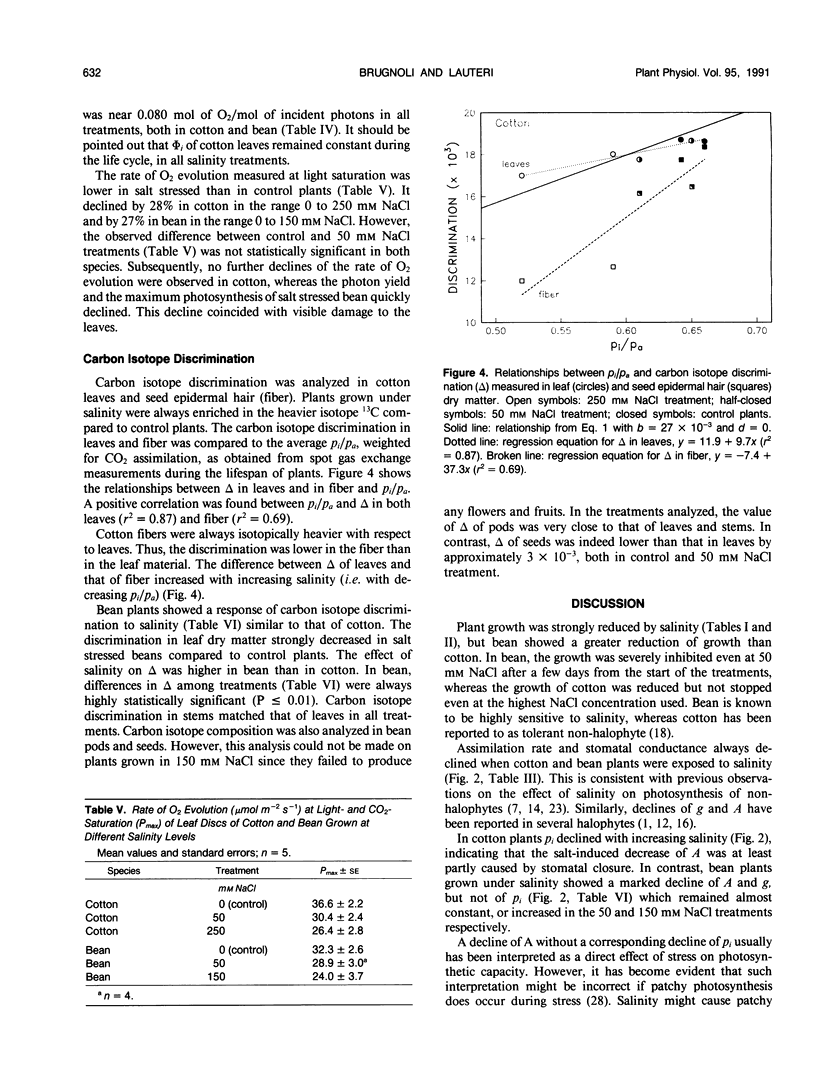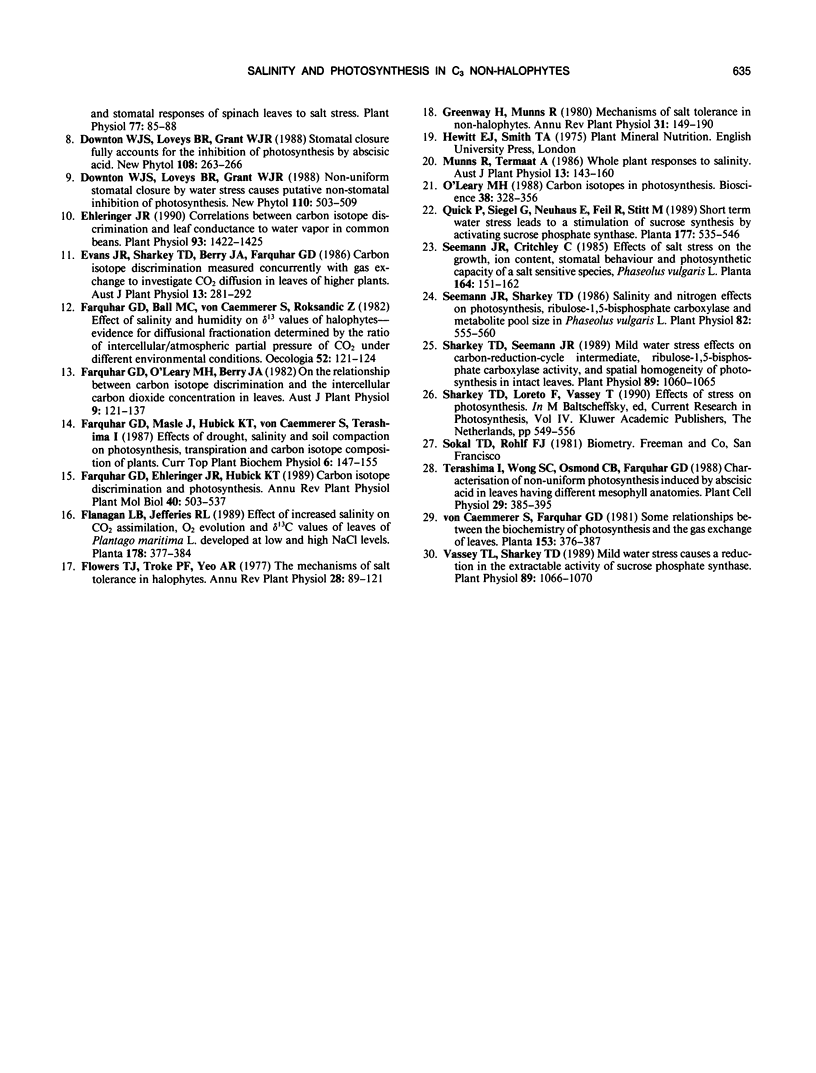Abstract
The effects of salinity on growth, stomatal conductance, photosynthetic capacity, and carbon isotope discrimination (Δ) of Gossypium hirsutum L. and Phaseolus vulgaris L. were evaluated. Plants were grown at different NaCl concentrations from 10 days old until mature reproductive structures were formed. Plant growth and leaf area development were strongly reduced by salinity, in both cotton and bean. Stomatal conductance also was reduced by salinity. The Δ always declined with increasing external salinity concentration, indicating that stomatal limitation of photosynthesis was increased. In cotton plant dry matter, Δ correlated with the ratio of intercellular to atmospheric CO2 partial pressures (pl/pa) calculated by gas exchange. This correlation was not clear in bean plants, although Δ showed a more pronounced salt induced decline in bean than in cotton. Possible effects of heterogeneity of stomatal aperture and consequent overestimation of pl as determined from gas exchange could explain these results. Significant differences of Δ between leaf and seed material were observed in cotton and bean. This suggests different patterns of carbon allocation between leaves and seeds. The photon yield of O2 evolution determined at rate-limiting photosynthetic photon flux density was insensitive to salinity in both species analyzed. The light- and CO2-saturated rate of CO2 uptake and O2 evolution showed a salt induced decline in both species. Possible explanations of this observation are discussed. O2 hypersensitivity was observed in salt stressed cotton plants. These results clearly demonstrate that the effect of salinity on assimilation rate was mostly due to the reduction of stomatal conductance, and that calculation of pl may be overestimated in salt stressed plants, because of heterogeneity of stomatal aperture over the leaf surface.
Full text
PDF







Selected References
These references are in PubMed. This may not be the complete list of references from this article.
- Ball M. C., Farquhar G. D. Photosynthetic and Stomatal Responses of Two Mangrove Species, Aegiceras corniculatum and Avicennia marina, to Long Term Salinity and Humidity Conditions. Plant Physiol. 1984 Jan;74(1):1–6. doi: 10.1104/pp.74.1.1. [DOI] [PMC free article] [PubMed] [Google Scholar]
- Brugnoli E., Hubick K. T., von Caemmerer S., Wong S. C., Farquhar G. D. Correlation between the Carbon Isotope Discrimination in Leaf Starch and Sugars of C(3) Plants and the Ratio of Intercellular and Atmospheric Partial Pressures of Carbon Dioxide. Plant Physiol. 1988 Dec;88(4):1418–1424. doi: 10.1104/pp.88.4.1418. [DOI] [PMC free article] [PubMed] [Google Scholar]
- Ehleringer J. R. Correlations between Carbon Isotope Discrimination and Leaf Conductance to Water Vapor in Common Beans. Plant Physiol. 1990 Aug;93(4):1422–1425. doi: 10.1104/pp.93.4.1422. [DOI] [PMC free article] [PubMed] [Google Scholar]
- Seemann J. R., Sharkey T. D. Salinity and Nitrogen Effects on Photosynthesis, Ribulose-1,5-Bisphosphate Carboxylase and Metabolite Pool Sizes in Phaseolus vulgaris L. Plant Physiol. 1986 Oct;82(2):555–560. doi: 10.1104/pp.82.2.555. [DOI] [PMC free article] [PubMed] [Google Scholar]
- Sharkey T. D., Seemann J. R. Mild water stress effects on carbon-reduction-cycle intermediates, ribulose bisphosphate carboxylase activity, and spatial homogeneity of photosynthesis in intact leaves. Plant Physiol. 1989 Apr;89(4):1060–1065. doi: 10.1104/pp.89.4.1060. [DOI] [PMC free article] [PubMed] [Google Scholar]
- Vassey T. L., Sharkey T. D. Mild Water Stress of Phaseolus vulgaris Plants Leads to Reduced Starch Synthesis and Extractable Sucrose Phosphate Synthase Activity. Plant Physiol. 1989 Apr;89(4):1066–1070. doi: 10.1104/pp.89.4.1066. [DOI] [PMC free article] [PubMed] [Google Scholar]


